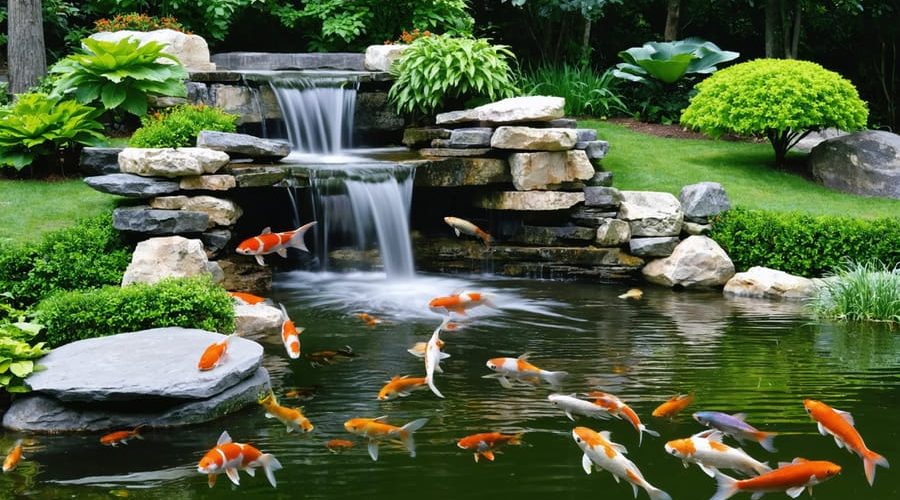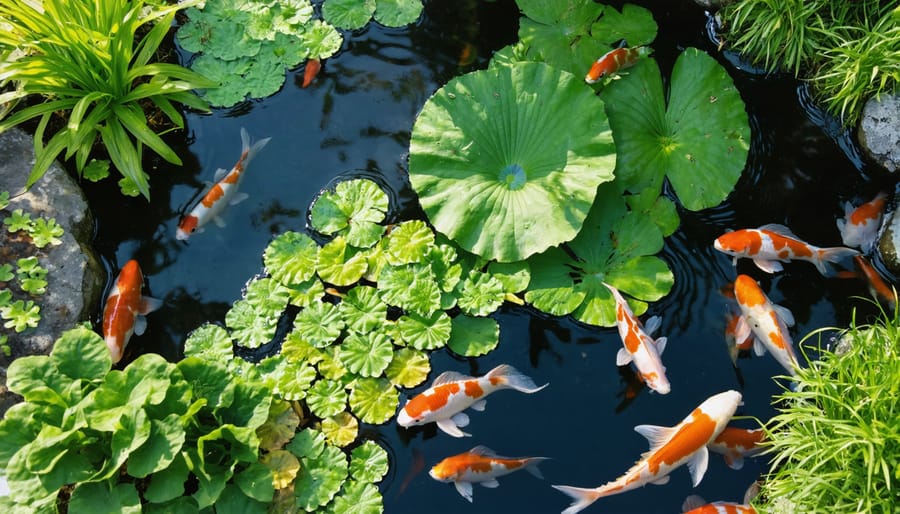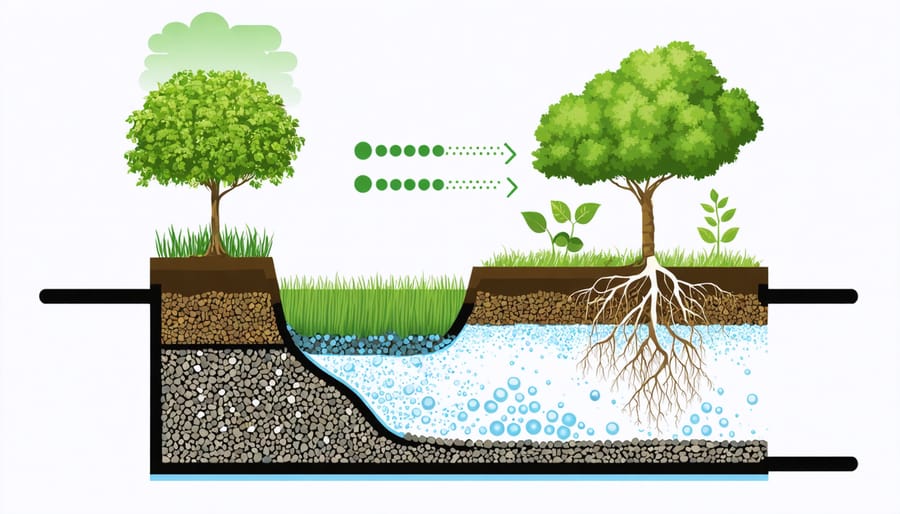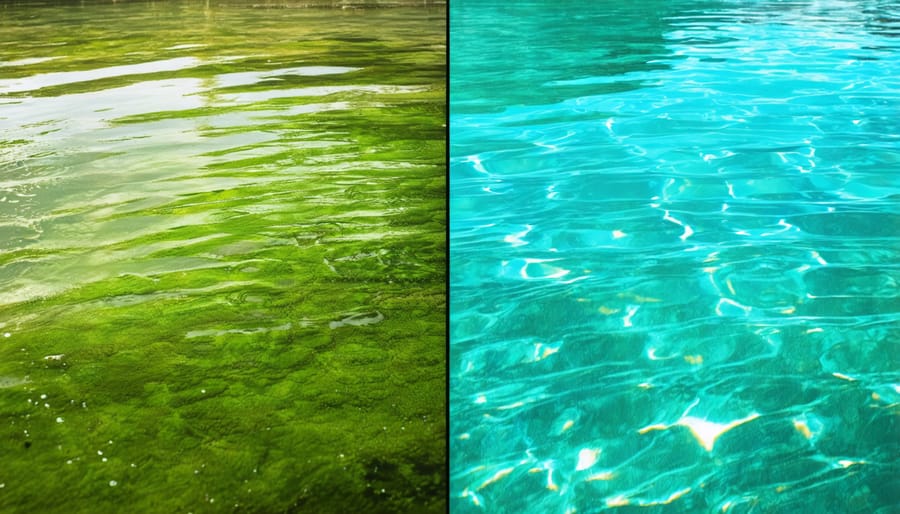
Natural Balance: How Traditional Water Gardens Create Perfect Ecosystems
Transform your garden into a thriving ecosystem by integrating traditional water garden principles with modern ecological practices. Plant native species in layers, mimicking natural habitats, to create self-sustaining biodiversity that naturally controls pests and reduces maintenance. Position water-loving plants strategically around pond edges to filter nutrients, while floating vegetation provides essential shade and shelter for aquatic life. Establish beneficial microorganisms through careful substrate selection and proper water circulation, eliminating the need for chemical treatments.
Ecological gardening revolutionizes traditional landscaping by working with nature rather than against it. This approach creates resilient, low-maintenance spaces that support local wildlife while reducing water consumption and eliminating harmful chemicals. By understanding and implementing these natural systems, gardeners can develop stunning, sustainable landscapes that improve environmental health and require minimal intervention to thrive.
The secret lies in viewing your garden as an interconnected web of life rather than isolated plants and features. Each element – from soil microbes to pollinating insects – plays a crucial role in maintaining balance and promoting natural growth cycles. This holistic approach not only produces beautiful results but also contributes to broader environmental conservation efforts.

The Living Web: Understanding Water Garden Ecosystems
The Plant-Fish Connection
In a natural water garden, plants and fish create a beautiful partnership that benefits both species. Plants provide essential shelter for fish, protecting them from predators and offering shady spots to rest. Fish, in turn, help keep the water clean by eating algae and small insects, while their waste serves as valuable fertilizer for the plants.
Aquatic plants act as natural filters, absorbing excess nutrients that could otherwise lead to algae blooms. They take up nitrates and phosphates from fish waste, transforming these potential pollutants into lush growth. The plants’ roots also create micro-ecosystems where beneficial bacteria thrive, further helping to break down organic matter and maintain water quality.
Fish contribute to plant health by stirring up sediment as they swim, which helps distribute nutrients throughout the water. Some fish species, like koi and goldfish, will even help control unwanted plant growth by nibbling on excess vegetation. This natural give-and-take relationship creates a self-sustaining ecosystem that requires minimal intervention, making your water garden both beautiful and low-maintenance.
Beneficial Bacteria and Microorganisms
Think of beneficial bacteria and microorganisms as your pond’s tiny cleanup crew! These microscopic helpers break down waste, fallen leaves, and excess nutrients that would otherwise pollute your water. Just like our gut needs good bacteria to stay healthy, your pond ecosystem relies on these invisible workers to maintain crystal-clear water.
These helpful microorganisms naturally colonize your pond, creating biofilms on rocks, plants, and filter media. They convert harmful ammonia from fish waste into less toxic substances through a process called the nitrogen cycle. Some bacteria even help control algae growth by competing for the same nutrients that algae need to thrive.
To encourage these beneficial bacteria, avoid harsh chemical treatments that can kill both good and bad microorganisms. Instead, provide plenty of surface area through rocks, gravel, or biological filter media where they can establish colonies. Adding pond plants also creates more spaces for beneficial bacteria to grow while helping to maintain oxygen levels these microorganisms need to function effectively.
Remember, a healthy bacterial population takes time to establish, so be patient as your pond’s ecosystem develops its natural balance.
Traditional Water Management Techniques
Natural Filtration Systems
Natural filtration systems are nature’s way of keeping water clean and healthy, drawing inspiration from Japanese water garden wisdom that has been perfected over centuries. These systems work by mimicking the natural processes found in wetlands and streams, using a combination of carefully selected plants and layered gravel beds to purify water.
The process starts with a settling zone where larger particles sink to the bottom. Water then flows through gravel beds of varying sizes, creating spaces for beneficial bacteria to thrive. These microscopic helpers break down harmful compounds and excess nutrients. Above the gravel, water-loving plants like rushes, iris, and cattails work their magic by absorbing nitrates and other pollutants through their roots.
To create your own natural filtration system, start with a pre-filter zone filled with coarse gravel, followed by medium and fine gravel layers. Plant water-purifying species at different depths – some floating, others partially submerged, and some completely underwater. Popular choices include water hyacinth, hornwort, and marsh marigold.
The beauty of natural filtration is its self-sustaining nature. Once established, these systems require minimal maintenance while providing a home for beneficial insects, amphibians, and other wildlife that contribute to your garden’s ecosystem. Regular pruning of plants and occasional gravel cleaning are usually all that’s needed to keep the system running smoothly.

Water Flow and Oxygenation
Maintaining proper water flow and oxygen levels is essential for a thriving ecological garden pond. Traditional methods have stood the test of time, offering reliable ways to keep water healthy without relying on complex equipment.
One of the simplest approaches is creating a cascade or waterfall feature. As water tumbles down different levels, it naturally incorporates oxygen while creating a beautiful focal point. Even a small drop of a few inches can make a significant difference in oxygenation levels.
Moving water plants strategically around your pond also helps with oxygen distribution. Water lilies and floating plants should cover about 60-70% of the surface, leaving open areas where oxygen can easily transfer between air and water. Too much coverage can actually reduce oxygen levels, while too little might lead to excessive algae growth.
Consider adding submerged plants like hornwort or waterweed, which naturally release oxygen during photosynthesis. These plants work hardest during daylight hours when oxygen demands are highest.
For smaller ponds, a basic fountain can provide adequate circulation. The spray pattern breaks the water surface, incorporating air while creating pleasant sounds. In larger setups, combining multiple methods often works best – perhaps a small waterfall on one end and strategically placed plants throughout.
Remember that fish and other aquatic life need more oxygen during warm weather, so you might need to adjust your approach seasonally. A gentle ripple across the surface is usually a good indicator that you’re maintaining healthy oxygen levels.
Seasonal Care for Ecological Balance
Spring and Summer Management
Spring and summer are the most active seasons in your ecological garden, requiring thoughtful management to maintain natural balance. As temperatures rise, start by gently cleaning out any debris that accumulated over winter, being careful not to disturb beneficial organisms that have made your garden their home.
Monitor plant growth closely during these vigorous seasons. Trim back fast-growing plants before they take over, and remove about one-third of floating plant coverage to maintain proper water circulation and sunlight penetration. This balance is crucial for oxygen levels and overall ecosystem health.
Add beneficial bacteria monthly to help break down organic matter and maintain water clarity naturally. If you notice algae beginning to bloom, consider adding more floating plants rather than reaching for chemical solutions. They’ll compete with algae for nutrients while providing shade and habitat for wildlife.
Keep an eye on water levels during hot weather, topping up when necessary with collected rainwater if possible. This helps maintain stable conditions for your garden’s inhabitants. During summer, feed fish sparingly as they’re more active and can find natural food sources within the ecosystem.
Remember to observe your garden regularly. The best ecological gardens develop their own rhythm, and your role is to guide rather than control. Make small adjustments rather than dramatic changes, allowing the natural systems to find their balance.
Fall and Winter Preparation
As autumn approaches, your ecological garden needs special attention to ensure it remains healthy through the dormant season. Start by gradually reducing feeding as temperatures drop, allowing plants and wildlife to prepare naturally for winter. Remove fallen leaves from water features before they sink and decompose, but consider creating a leaf pile nearby as winter shelter for beneficial insects and small animals.
Trim back dying plant material, leaving some seed heads for birds and winter interest. However, avoid cutting everything back – dead plant stalks provide crucial winter homes for beneficial insects and natural protection for plant roots. For marginal plants, move tender species to deeper water where they won’t freeze solid.
Consider installing a small pump or aerator to maintain a hole in the ice during winter, allowing toxic gases to escape and providing drinking water for wildlife. If you have fish, ensure they have enough depth (at least 2-3 feet) to survive below the freeze line.
Add floating balls or similar devices to protect pump equipment from ice damage, but avoid breaking ice manually as this can harm hibernating wildlife. Apply winter netting early to catch falling leaves and remove it once trees are bare.
In regions with harsh winters, consider adding extra protection for sensitive plants using natural materials like straw or pine boughs. These methods protect your garden’s ecosystem while supporting wildlife through the challenging winter months.
Common Problems and Natural Solutions

Algae Control Without Chemicals
Controlling algae naturally is a time-tested practice that dates back to ancient water purification methods, and today’s eco-conscious gardeners have several effective options at their disposal. The key to natural algae control lies in creating a balanced ecosystem that self-regulates.
Start by introducing floating plants like water lilies and lotus, which shade the water surface and compete with algae for nutrients. Aim to cover about 60-70% of your pond’s surface with these beautiful plants. Adding submerged oxygenating plants like hornwort or anacharis helps absorb excess nutrients while producing vital oxygen for aquatic life.
Beneficial bacteria play a crucial role in breaking down organic matter before it can feed algae. You can encourage their growth by adding clean rock or gravel to your pond, creating natural biological filtration zones. Consider installing a small waterfall or fountain to keep water moving – algae struggles to thrive in moving water, plus the sound adds a lovely sensory element to your garden.
One often-overlooked method is using barley straw. As it decomposes, it releases compounds that naturally inhibit algae growth. Simply place fresh barley straw in mesh bags around your pond’s edge, replacing it every 4-6 months.
Remember to maintain a healthy fish population that helps control algae naturally, but don’t overstock. Too many fish produce excess waste that can fuel algae growth. Regular maintenance like removing fallen leaves and debris prevents nutrient buildup that algae thrives on, keeping your pond naturally clear and beautiful.
Natural Pest Management
Managing pests naturally is all about creating a balanced garden ecosystem where beneficial creatures help control unwanted insects. Start by attracting natural predators like ladybugs, praying mantises, and birds to your garden. You can do this by planting flowers like marigolds, lavender, and native wildflowers that these helpful creatures love.
Companion planting is another effective strategy. Plant aromatic herbs like basil, mint, and rosemary throughout your garden – they naturally repel many common pests while attracting pollinators. Garlic and onions are particularly good at deterring aphids and other soft-bodied insects.
Physical barriers work wonders too. Use row covers to protect young plants, and install copper tape around container gardens to deter slugs and snails. For larger pests, consider installing wildlife-friendly fencing that allows beneficial animals to pass through while keeping unwanted visitors out.
When you do spot pest problems, start with the gentlest solution first. A strong stream of water can knock off aphids, and hand-picking larger insects like caterpillars is often effective. For stubborn issues, try making your own natural pest sprays using ingredients like neem oil, diluted soap solution, or garlic and chili pepper mixtures.
Remember that some pest presence is normal and even beneficial – it provides food for natural predators. The goal isn’t to eliminate all insects but to maintain a healthy balance. Regular monitoring helps you catch problems early when they’re easier to manage naturally. By working with nature rather than against it, you’ll create a resilient garden that largely manages pests on its own.
Embracing ecological water garden management isn’t just about creating a beautiful outdoor space – it’s about becoming a steward of your local environment. By working with nature rather than against it, you’re creating a sustainable ecosystem that benefits local wildlife, reduces maintenance costs, and provides endless enjoyment for years to come.
Remember that every sustainable choice you make has a ripple effect. Using native plants helps support local pollinators and reduces the need for chemical interventions. Natural filtration systems, powered by beneficial bacteria and aquatic plants, keep your water crystal clear without harmful chemicals. Creating diverse habitats attracts beneficial insects and animals that naturally control pests and maintain balance in your garden.
The benefits extend beyond your garden’s boundaries. By reducing chemical use, you’re protecting groundwater and nearby natural water bodies. Using rainwater collection and efficient irrigation systems helps conserve precious water resources. Plus, the wildlife sanctuary you’ve created contributes to the broader ecological corridor in your community.
Starting your ecological water garden journey might seem challenging at first, but the rewards are worth it. Take small steps, observe how your garden responds, and adjust your approach accordingly. Whether you’re maintaining an existing water feature or planning a new one, choosing ecological methods will create a thriving, self-sustaining garden that brings joy while protecting our environment for future generations.
Remember, every sustainable garden contributes to a healthier planet. Your choices matter, and your ecological water garden can inspire others to embrace natural gardening practices too.
